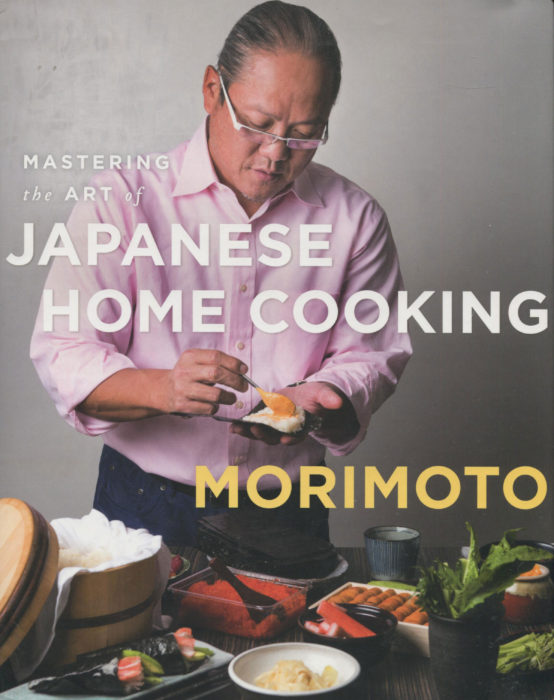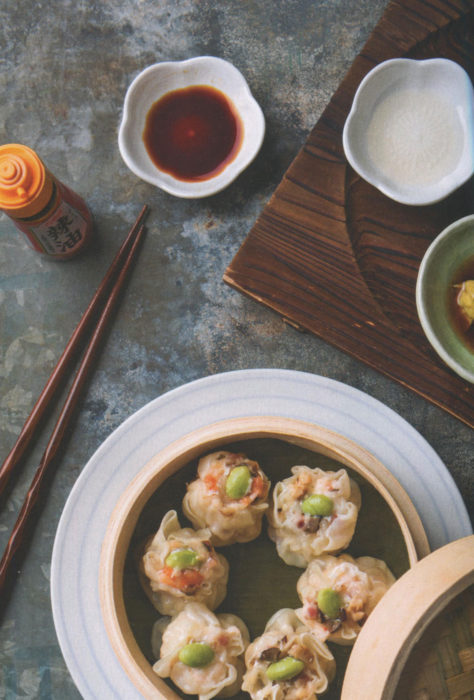
This is a beautiful, important and intelligent cookbook. The title is key and revealing. This is a type of art book, for authentic Japanese cooking is surely an art form.
I always carry the impression that Japanese culture is more complex and richer than ours. The colors, the detail, the painstaking calligraphy, the hand-crafted architecture, the gardens, and the food. I was twenty-nine when I had my first meal in a Japanese restaurant. It was an experience that I have never forgotten and I reinforce it with a weekly return to one of several Japanese restaurants near me. It is far more than the flavors. It is the appearance, the perfect positioning of food on the plate, the whole asymmetric geometry, the sauces on the side. It’s everything.
Of course, loving this style of food, how could I possibly hope to reproduce it at home? You can’t. Or, until now, you couldn’t. But Iron Chef Masaharu Morimoto has authored a book that, in parallel to Julia Child’s masterwork, lays out the essentials and the techniques for the ideals of Japanese cuisine. The book is carefully written and truly gives you a path to excellence in Japanese food in your home.
There are two kinds of chapters in this book: ingredients and techniques. The first two chapters deal with ingredients, but perhaps not the ones you might expect. They are Dashi, or Japanese stock, and Gohan, or rice. Those two “simple” things are essentials to be employed throughout the rest of the book.
Dashi is the secret weapon of Japanese cuisine and you’ve surely tasted it. It’s the basis for soups, for cooking veggies, for adding flavor to chicken and rice dishes. It is ubiquitous, a combination of dried kelp and bonito flakes, cooked very carefully so that the essence of the sea arrives on your plate.
In the Gohan chapter — the word means both “rice” and “meal” — it is suggested that a serious rice maker appear in your kitchen. Morimoto says to skip the cheap models and the highly expensive one [thousands of dollars]. An intermediate machine, with a few settings like for brown rice, will give you the rice foundation you need for the recipes in this book. Without great rice, Japanese food is compromised. And Morimoto’s style is to be uncompromised.
The rest of the book is devoted to a diversity of techniques and recipes that will keep you occupied for weeks. Here soups and noodles seem to steam off the page. There is nothing “simple” about Miso Soup with Tofu. Complexity in appearance and flavor is evident tin the Japanese Egg Drop Soup. Once you have had a true udon noodle — long, thick and yet intriguingly soft — you quickly become addicted. Here you can enjoy those noodles with scallion and ginger and even a “clay pot” soup.
Technique chapters are devoting all the styles perfected for Japanese kitchens:
- Yaku: to grill, boil and sear
- Musu: to steam
- Niru: to simmer
- Itame Ru: to stir-fry
- Ageru: to Fry
- Tsukeru: to pickle
All those marvels from the menu of your local Japanese restaurant appear here:
Yakitori on sticks
Shumai Dumplings
Oden or Japanese Hot Pot
Stir Fried Veggies with Noodles
Tempura
Tonkatsu
Cucumber Pickles
The recipes here have been fashioned by Morimoto so, yes, you can do them in your home kitchen. They will take some time and some patience. This is not meal loaf or mac and cheese food. There is detail and complexity here, a demand for attention and precision. But that effort is always worth the effort. This post ends with a photo of the Shumai, those steamed shrimp dumplings you may have enjoyed as an appetizer. The filling for these small bites requires a big cooking experience: shrimp, onion, cornstarch, mushrooms, bacon, scallion, egg, sake, ginger, salt, sugar, and sesame oil.
After your first Shumai, you will be hooked. I’ll post the Shumai recipe later this week. That, and the Tonkatsu, plus some Miso Soup, make the perfect Japanese meal. I know. It’s the one I do at least once a week, with a little Udon variation now and then. As a fan of Japanese food, I smile with each meal — and, yes, I think it is a tad bit healthier than those enchiladas down the street. Now, with this Mastering the Art tome, I can enjoy those flavors more often and perhaps introduce a little more Zen into my kitchen.
Oh, the Tonkatsu. It’s fried pork cutlet, sliced into strips, and offered with Tonkatsu Sauce, sweet and pungent. When you read Morimoto’s recipe for the sauce, and the discussion about why you need to make your own and not buy bottled versions, then you realize what a master chef he is. And why you can trust every page of Mastering the Art of Japanese Home Cooking.

